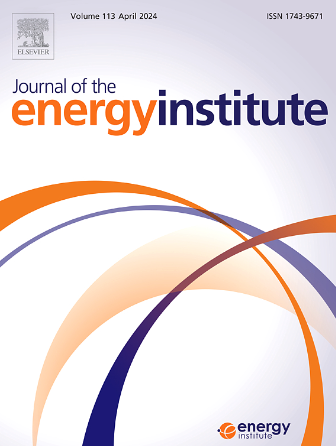火电厂无碳能源转换降管炉不同固体燃料类型注氨策略实验评价
IF 5.6
2区 工程技术
Q2 ENERGY & FUELS
引用次数: 0
摘要
氨以其高氢含量和良好的储存性能而闻名,正在成为全球能源转型的关键碳中性燃料。韩国的目标是到2027年在现有的燃煤电厂锅炉上示范氨的应用,目标是减少二氧化碳的排放。然而,这一领域的研究是至关重要的,因为对发电厂运行至关重要的可燃性和废气成分可能会发生变化。本文研究了氨滴管炉(ADTF)喷氨位置和煤品位对燃煤电厂可燃性和废气排放的影响。实验结果表明,注氨位置对燃烧性能和废气排放有显著影响。与烟煤(煤A)相比,亚烟煤(煤B)挥发物含量更高,可燃性更强,未燃烧碳(UBC)排放量更低。由于氨的还原剂作用,向下游注入氨可显著减少氮氧化物排放。特别是B煤,在最低位置注入时,其排放量(91.74 ppm)低于煤完全燃烧时的排放量(123.82 ppm)。混合煤的燃烧趋势与A煤相似;但是,它为提高高品位煤的利用提供了一条可行的途径,并且在某些方面表现出比单一煤更优越的排放特性。这些发现证明了氨煤共烧在减少煤燃烧过程中CO2和NOx排放,同时提高锅炉燃烧效率的潜力。这些见解有望为氨煤共烧发电示范项目做出重大贡献。本文章由计算机程序翻译,如有差异,请以英文原文为准。
Experimental evaluation of ammonia injection strategies for different solid fuel types in drop tube furnace for carbon-free energy transition in thermal power plants
Ammonia, known for its high hydrogen content and favorable storage properties, is emerging as a key carbon-neutral fuel for the global energy transition. South Korea aims to demonstrate the application of ammonia in existing coal-fired power plant boilers by 2027, targeting a reduction in CO2 emissions. However, research in this area is crucial because the combustibility and exhaust gas composition, which are vital for power plant operations, may change. This study investigates the impact of ammonia injection position and coal grade on combustibility and exhaust gas in coal-fired power plants using an ammonia drop tube furnace (ADTF). Experimental results indicate that ammonia injection position significantly influences combustibility and exhaust gas. Sub-bituminous coal (Coal B), with higher volatile matter content, exhibited enhanced combustibility and lower unburned carbon (UBC) emissions compared to bituminous coal (Coal A). NOx emissions were significantly reduced when ammonia was injected downstream because of its function as a reducing agent. Particularly for coal B, when injected at the lowest position, it exhibited a lower emission (91.74 ppm) compared to the complete combustion of the coal (123.82 ppm). The combustion trends of mixed coal resembled those of Coal A; however, it presented a viable approach for enhancing high-grade coal utilization and demonstrated superior emission characteristics in certain respects compared to single coal. These findings demonstrate the potential of ammonia-coal co-firing to reduce CO2 and NOx emissions in coal combustion while improving boiler combustion efficiency. Such insights are expected to significantly contribute to the demonstration project of ammonia-coal co-firing power generation.
求助全文
通过发布文献求助,成功后即可免费获取论文全文。
去求助
来源期刊

Journal of The Energy Institute
工程技术-能源与燃料
CiteScore
10.60
自引率
5.30%
发文量
166
审稿时长
16 days
期刊介绍:
The Journal of the Energy Institute provides peer reviewed coverage of original high quality research on energy, engineering and technology.The coverage is broad and the main areas of interest include:
Combustion engineering and associated technologies; process heating; power generation; engines and propulsion; emissions and environmental pollution control; clean coal technologies; carbon abatement technologies
Emissions and environmental pollution control; safety and hazards;
Clean coal technologies; carbon abatement technologies, including carbon capture and storage, CCS;
Petroleum engineering and fuel quality, including storage and transport
Alternative energy sources; biomass utilisation and biomass conversion technologies; energy from waste, incineration and recycling
Energy conversion, energy recovery and energy efficiency; space heating, fuel cells, heat pumps and cooling systems
Energy storage
The journal''s coverage reflects changes in energy technology that result from the transition to more efficient energy production and end use together with reduced carbon emission.
 求助内容:
求助内容: 应助结果提醒方式:
应助结果提醒方式:


